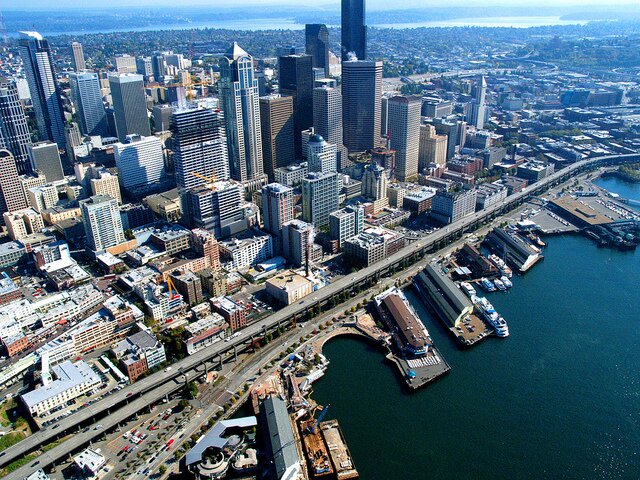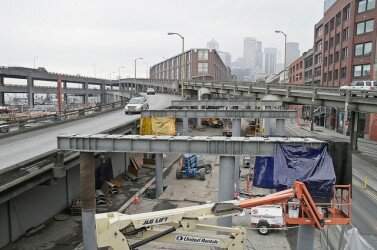Checking WSDOT Math on the Deep-Bore Tunnel

Photo: Washington State Department of Transportation
It’s fun to watch PR in action. Seattlepi.com has a story, “Price tag to kill tunnel: More than $1 billion” that purports to explain why the tunnel project is such a juggernaut it cannot be stopped. The thrust of what Ron Paananen, the Alaskan Way Viaduct replacement project administrator, told Seattlepi.com is that since WSDOT has either spent (or secured specifically for the tunnel) most of the $1 billion in savings that might have accrued from pursuing the surface/I-5/transit option, you might as well green-light $2 billion more.
Keep in mind a few things. The final environmental impact statement is not due out until this summer. Washington’s Administrative Code says, “Until the state “issues a final determination of non significance or final environmental impact statement, no action concerning the proposal shall be taken by a governmental agency that would… limit the choice of reasonable alternatives,” emphasis from The Stranger‘s Dominic Holden.
Is WSDOT a governmental agency? Are they telling Seattlepi.com that they have in fact taken $645 million in action that limits the choice of reasonable alternatives?
As of this month, about $645 million has been spent on the viaduct project, including construction that began this year on a new six-lane surface highway replacement for the viaduct’s southern mile between Holgate and King Streets. WSDOT, which now is spending about $15 million to $20 million per month on the viaduct project, also has paid for environmental work and purchasing right-of-way prior to tunnel construction, Paananen said.
[UPDATE: WSDOT clarifies that money-spent-thus-far includes "Electrical Line Relocation work, the work done in 2007 to stabilize columns of the viaduct near Yesler, the installation of automated viaduct closure gates system (which will be complete next month), and funding towards projects such as SR 519 Phase 2, Spokane Street Viaduct Fourth Avenue off-ramp, I-5 active traffic management, I-5 travel time signs, and intelligent transportation systems." See this handy .pdf checklist for projects funded so far: 2011_0124_BoredTunnel_CostFunding_folio_web.]

Photo: Washington Department of Transportation
Well, no, they are not, when it comes right down to it. If you call them, WSDOT is careful to emphasize that the southern mile is “alternative neutral.” The environmental impact review for that part of the project has been finalized, and it is able to link up to whatever solution might be put in place for the central Viaduct replacement. That southern portion of the $3.1 billion Viaduct replacement project was projected to cost $476 million (in 2010), and assuming it was on or below budget, then WSDOT has spent “just” $169 million on specifically tunnel-related elements. [See the update above for a much more detailed breakout of where WSDOT has spent funds. The summary still stands: It would not be a waste of funds to halt the tunnel and switch to a better alternative.]
In fairness, Seattlepi.com’s Scott Gutierrez doesn’t seem to be including all the alternative costs when he writes, “If WSDOT were to start anew with $1.1 billion, that probably would be enough to afford one option: the so-called surface/transit option…” That lowball cost he mentions isn’t the full cost for the more proactive surface/I-5/transit option that was developed to deal with the predicted congestion. Transit is expensive, that’s why the $190 million the tunnel plan allocates for RapidRide, et al, is “not yet funded.” [UPDATE: More fun with .pdfs! See the fact sheet: AWV_I5SurfaceTransitHybrid_FactSheet_Dec08.]
Still, I get the impression that many people think of the surface/I-5/transit option as a do-nothing approach. Here’s Holden again (read the whole article) on all it does do:
Here’s how surface/transit would work: adding a new northbound lane on I-5 in the space already available between Seneca Street and the State Route 520 interchange (this alone provides capacity for an estimated 30,000 additional vehicles a day); converting Alaskan Way along the waterfront to a six-lane road south of Columbia Street and a four-lane road north of Columbia Street; placing timed traffic lights at intersections along the waterfront to maximize mobility while allowing drivers to turn east into the downtown core; making improvements for cyclists and pedestrians, such as redesigning certain sidewalks and clearly marking bike lanes; funding more bus routes; and establishing transit priority through Pike and Pine Streets, Madison and Marion Streets, and through Stewart Street and Olive Way. Meanwhile, Spokane Street and Mercer Street improvements would increase freight access to I-5.
Do you see that? The I-5 lane change alone gives you an extra 30,000 vehicle capacity per day at our most notorious chokepoint. That alone is close to the tunnel’s total projected usage, given the effects of $4-$5 each-way tolling. Unless you can recite all of this back to me, do not mention “gridlock” as your concern for the surface/I-5/transit plan.
-
http://www.facebook.com/alexjon Alex-jon Earl
-
Anonymous

 Daily Email Digest of The SunBreak
Daily Email Digest of The SunBreak